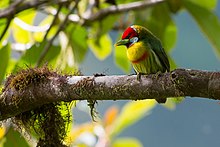Great Bearded Bird
| Great Bearded Bird | ||||||||||
|---|---|---|---|---|---|---|---|---|---|---|

Pair of Great Bearded Birds ( Eubucco versicolor ), male above, female below |
||||||||||
| Systematics | ||||||||||
|
||||||||||
| Scientific name | ||||||||||
| Eubucco versicolor | ||||||||||
| ( Statius Müller , 1776) |
The Versicoloured Barbet ( Eubucco versicolor ) is a bird art from the family of American barbets . The colorful species, which shows a very noticeable sexual dimorphism , is found in South America. Several subspecies are distinguished. The IUCN classifies the Great-Bearded Bird as not endangered ( least concern ).
Appearance
The males of the nominate form reach a wing length of 6.8 to 7.4 centimeters. The tail is between 4.7 and 5.6 inches long. The beak length is 1.8 to 2.2 centimeters.
The males have a fine black line on the right and left at the base of the beak, the forehead, the upper head and the ear covers are red. The region around the eyes is black. A fine, pale blue line separates the red skull from the greenish nape of the neck. The rest of the top of the body is green with a bluish tinge. The control springs are bronze-green with black-brown spring shafts. The chin is black, the red throat is framed by two pale blue spots. The chest is golden yellow. A red ribbon runs across the stomach and ends on the sides of the body. The sides of the body and flanks are striped dark green and white. The beak is long in relation to body size, the upper beak slightly curved. The beak color is lime green to yellow-green, the tip of the beak yellow. The featherless skin around the eyes is black, the eyes are dark red in most individuals.
In the female, the chin, the region between the beak and eyes and the forehead are black, while the ear covers and the throat are light blue. The top of the head is greenish-yellow, the nape a little greener. A yellow to dull orange stripe runs over the eyes and along the sides of the neck. The rest of the top of the body is greenish with a slightly more pronounced shade of blue than in the male. A narrow orange-red band separates the throat from the chest. The front breast is pale green-blue to pale yellowish-green. The lower breast is dull green-yellow. The sides of the body, the flanks and the belly as well as the under tail coverts are striped yellow-green.
The body shape of the red bearded birds is reminiscent of tangerines . The only other species of bearded bird with which the great blue bearded bird can be confused is the Andean bearded bird . The distribution areas of the two species overlap in northern Peru. The females of the red bearded birds can be distinguished from the females of the Andean bearded birds by their light blue throat. The males differ from the males of the Andean bearded birds by their bruises on the sides of their heads.
Distribution and way of life
The great whiskered bearded bird occurs in forests of the eastern Andes from northern Peru to central Bolivia. It usually lives at altitudes between 1000 and 2000 meters, but can also be found in northern Peru at altitudes of 675 meters.
The habitat requirements of the bearded bird have so far only been insufficiently investigated. It prefers humid, tropical and subtropical mountain forests with dense undergrowth and abundance of bromeliads, epiphytes and mosses. Occasionally it also penetrates into older secondary forests . It usually looks for food in trees at a height of around ten meters, but it can also come down to a meter close to the ground. Fruits make up most of its diet. But it also eats insects, which it usually finds by looking through dry leaves that have gathered in forked branches. It usually lives solitary, only on trees that bear abundant fruit are several Andean bearded birds occasionally observed. The reproductive biology of this species has not yet been studied.
supporting documents
literature
- Lester L. Short and Jennifer FM Horne: Toucans, Barbets and Honeyguides - Ramphastidae, Capitonidae and Indicatoridae . Oxford University Press, Oxford 2001, ISBN 0-19-854666-1
Individual evidence
Web links
- Eubucco versicolor inthe IUCN 2013 Red List of Threatened Species . Listed by: BirdLife International, 2012. Retrieved February 2, 2014.
